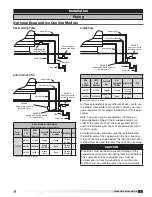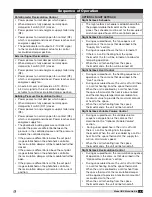
Model IGX Make-Up Air
34
®
Freeze Condition
• If the incoming air temperature is below the
evaporative cooling module freeze sensor (FRZ) set
point, the freeze sensor (FRZ) contacts will open,
de-energizing the auto drain and fill timer (TC) and
the supply drain valve (VSD).
• When the normally closed supply valve (VS) and
the normally open supply drain valve (VSD) are de-
energized, the supply line is drained.
• When the normally open drain valve (VD) is de-
energized, the evaporative cooling module sump is
drained.
Cooling Sequence - Chilled Water or Split System
DX Cooling
• Modulating or staged controls for chilled water and
split system DX coils are supplied by others. The
sequence of operation will depend on the controls
provided.
• The cooling relay (RC) normally open contacts may
be used to initiate the cooling sequence for the
controls supplied by others.
OPTIONAL VARIABLE VOLUME
Two Speed VFD Control
• When the supply fan relay (RF) is energized, the
normally open supply fan relay (RF) contacts are
closed. This creates a run command for the VFD.
• The run command allows the VFD to pass power
to the supply fan (M1). The supply fan (M1) will
operate at maximum speed.
• When the two speed supply fan contact (S2) is
switched to the low position, power is passed to
the low speed relay (RL) which is energized.
• The normally open low speed relay (RL) contacts
are closed commanding the VFD to low speed.
• The VFD controls supply fan M1 to operate at
minimum speed.
Potentiometer VFD Control
• When the supply fan relay (RF) is energized, the
normally open supply fan relay (RF) contacts are
closed. This creates a run command for the VFD.
• The run command allows the VFD to pass power
to the supply fan (M1). The supply fan (M1)
will operate at the speed commanded by the
potentiometer.
• The potentiometer will output a 2-10 VDC signal to
the VFD analog input terminal. A 2 VDC signal will
command the VFD to minimum speed. A 10 VDC
signal will command the VFD to maximum speed.
• The VFD controls the supply fan motor (M1) to the
speed commanded by the potentiometer.
External Signal VFD Control
• When the supply fan relay (RF) is energized, the
normally open supply fan relay (RF) contacts are
closed. This creates a run command for the VFD.
• The run command allows the VFD to pass power
to the supply fan (M1). The supply fan (M1) will
operate at the speed commanded by the external
signal provided by others.
• The external signal provided by others will send
a 2-10 VDC or a 4-20 mA signal to the VFD
analog input terminal. A 2 VDC or 4mA signal
will command the VFD to minimum speed. A
10 VDC or 20 mA signal will command the VFD to
maximum speed.
• The VFD controls the supply fan motor (M1) to the
speed commanded by the external signal.
Building Pressure VFD Control
• When the supply fan relay (RF) is energized, the
normally open supply fan relay (RF) contacts are
closed. This creates a run command for the VFD.
• The run command allows the VFD to pass power
to the supply fan (M1). The supply fan (M1) will
operate at minimum speed.
• The photohelic building pressure controller will
monitor the pressure differential between the
pressure in the controlled space and the pressure
outside the controlled space.
• If the pressure differential is below the set point
range established on the photohelic controller, the
VFD will increase the supply fan speed.
• If the pressure differential is above the set point
range established on the photohelic controller, the
VFD will decrease the supply fan speed.
• If the pressure differential is within the set point
range established on the photohelic controller,
the VFD will maintain the supply fan at its current
speed.
OPTIONAL RECIRCULATION
Two Position Recirculation Control
• Power passes to inlet damper which opens.
• When damper is fully opened, normally open
damper limit switch (DL1) closes.
• Power passes to and energizes supply starter relay
(RF).
• Power passes to normally open fan contact (RF),
which is energized and closed. Power reaches and
energizes supply fan. The recirculation damper is
closed.
• When the recirculation contact (S3) is closed,
the recirculation damper is opened to allow
recirculated air to enter the unit and mix with the
heated outside air.
Sequence of Operation















































